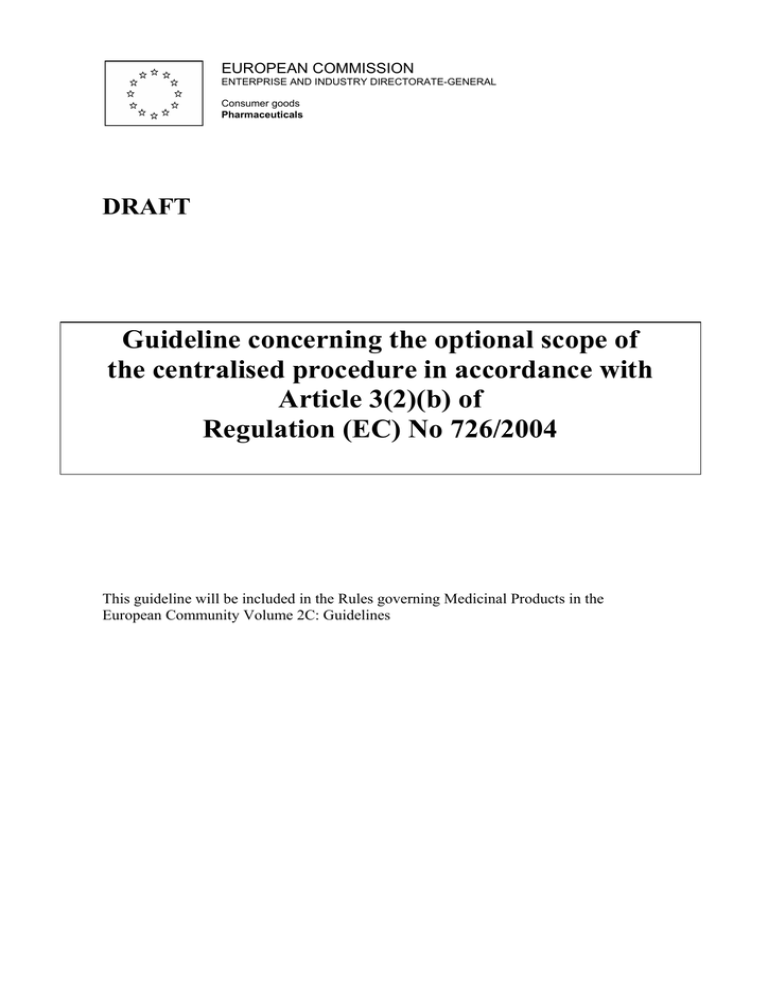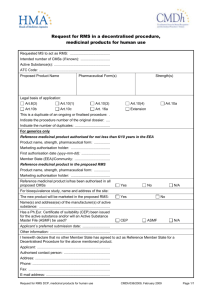Guideline concerning the optional scope of the centralised
advertisement

EUROPEAN COMMISSION ENTERPRISE AND INDUSTRY DIRECTORATE-GENERAL Consumer goods Pharmaceuticals DRAFT Guideline concerning the optional scope of the centralised procedure in accordance with Article 3(2)(b) of Regulation (EC) No 726/2004 This guideline will be included in the Rules governing Medicinal Products in the European Community Volume 2C: Guidelines DRAFT GUIDELINE On Article 3(2) of Regulation (EC) No 726/2004 “Optional scope of the centralised procedure” - Human medicinal products Introduction Article 3 of Regulation (EC) No 726/2004 of the European Parliament and of the Council defines the scope of the centralised procedure through which medicinal products must or may be authorised by the Community: - Article 3(1) defines the so called “mandatory” scope of the centralised procedure as defined in the Annex1 of Regulation (EC) No 726/2004: “No medicinal product appearing in the Annex may be placed on the market within the Community unless a marketing authorisation has been granted by the Community in accordance with the provisions of this Regulation.” - Article 3(2) defines the so called “optional” scope of the centralised procedure: “Any medicinal product not appearing in the Annex may be granted a marketing authorisation by the Community in accordance with the provisions of this Regulation, if: (a) the medicinal product contains a new active substance which on the date of entry into force of this Regulation, was not authorised in the Community; or (b) the applicant shows that the medicinal product constitutes a significant therapeutic, scientific or technical innovation or that the granting of authorisation in accordance with this regulation is in the interests of patients or animal health at Community level.” Consideration is also given to recital (9) of Regulation (EC) No 726/2004 which states: “As regards medicinal products for human use, optional access to the centralised procedure should also be provided for in cases where use of a single procedure produces added value for the patient. This procedure should remain optional for medicinal products which, although not belonging to the abovementioned categories, are nevertheless therapeutically innovative. (…).” This guideline applies to human medicinal products and provides guidance on: 1 For human medicinal product, these products include: Medicinal products developed by means of one of the following biotechnological processes: recombinant DNA technology, controlled expression of genes coding for biologically active proteins in prokaryotes and eukaryotes including transformed mammalian cells, hybridoma and monoclonal antibody methods. Medicinal products for human use containing a new active substance which, on the date of entry into force of this Regulation, was not authorised in the Community, for which the therapeutic indication is the treatment of any of the following diseases: AIDS, cancer, neurodegenerative disorder, diabetes, and with the effect from 20 May 2008 autoimmune diseases and other immune dysfunctions, viral diseases. Medicinal products that are designated as orphan medicinal products. - - EMEA procedure for confirmation of eligibility to the centralised procedure - Definition of new active substance not authorised in the Community, at the time of entry into force of the Regulation, - Justification of significant therapeutic, scientific or technical innovation. - Eligibility based on interests of patients at Community level It should be noted that in case of a medicinal product falling under the scope of Article 3(2) of Regulation (EC) No 726/2004, the choice of the authorisation procedure (centralised, mutual recognition or decentralised) is up to the applicant. Furthermore, it should also be noted that access to the centralised procedure does not pre-empt the outcome of the validation which will be done according to the legal basis chosen by the Applicant and the data submitted in support of an application for marketing authorisation. I. Procedure for confirmation of the eligibility to the centralised procedure In the case of a product falling under the scope of Article 3(2) of Regulation (EC) No 726/2004, before submission of the dossier, applicants should notify the EMEA of their intention to submit an application, preferably 18 months in advance (see the PreSubmission guidance document for further information) and justify why the product should qualify for the eligibility for the centralised procedure, citing the relevant specific provision(s) of Regulation (EC) No 726/2004. The eligibility of a medicinal product to the centralised procedure will be evaluated on a case-by-case basis. Justifications of eligibility will be evaluated by the Agency with consultation of the CHMP and, when needed, the relevant Working Parties. EMEA will notify confirmation of the eligibility or not to the centralised procedure. II. Addressing the criteria of a new active substance not authorised in the Community “A new active substance not authorised in the Community, at the time of entry into force of the Regulation” means a medicinal product containing a new active substance that was not authorised in the Community (i.e. in any Member State) on 20 November 2005. Examples of such new active substances which were not previously authorised in the Community include but are not limited to the following types: • A new chemical or biological2 substance. • A new radiopharmaceutical substance, which is a new radionuclide or a new ligand, or the coupling mechanism to link the molecule and the radionuclide is new. • A different salt, ester, ether, isomer, mixture of isomers, a complex or derivative of a chemical substance which differs significantly in properties with regard to safety and/or efficacy from a chemical substance of an authorised medicinal product. 2 It should be noted that paragraph 4 of Annex I of Regulation 1085/2003 states that “A biological medicinal product is a product, the active substance of which is a biological substance. A biological substance is a substance that is produced by or extracted from a biological source and for which a combination of physico-chemicalbiological testing and the production process and its control is needed for its characterisation and the determination of its quality.” • A biological substance which differs in molecular structure from that of a medicinal product previously authorised. • A new fixed combination of active substances. III. Addressing the criteria of significant therapeutic, scientific or technical innovation For the purpose of determining its opinion on whether a “medicinal product constitutes a significant therapeutic, scientific or technical innovation”, the Agency will consider if: - the medicinal product provides a completely new alternative to patients in treating, preventing or diagnosing a disease, or, - the medicinal product development is based on significant new scientific knowledge or on the application of a new scientific knowledge, or, - a new technology or a new application of technology is used for the development or the manufacture of the medicinal product. A non-exhaustive list of examples of such products is given below according to the types of innovation. It should nevertheless be noted that there may be overlap between the type of innovation; e.g. a consequence of an innovative delivery system could be a significant and innovative therapeutic use. Therapeutic innovation • Medicinal products presented for a new indication. (For justification of new indication, see Notice to Applicant [under revision]/Draft Guideline on element required to support the significant clinical benefit in comparison with existing therapies of new therapeutic indication in order to benefit from an extended marketing authorisation period in accordance with the article 14(11) of Regulation (EC) No 726/2004.) Scientific innovation • Medicinal products based on the application of new scientific knowledge (e.g. in the field of molecular biology, pharmacogenetic or pharmacogenomic) allowing a more safe and/or effective use of a substance. • Medicinal products which development used significant innovative non-clinical test (e.g. toxicogenomic) allowing a better evaluation of the substance safety. Technical innovation • Medicinal products administered by means of new delivery systems. • Medicinal products with new targeting or activation processes for active substances. • Medicinal products developed by new biological processes, which do not fall within the categories of medicinal products mentioned in the Annex to Regulation (EC) No 726/2004. • Medicinal products the manufacture of which employs new processes which demonstrate a significant technical advance. • Medicinal products containing a biological substance which has been previously authorised as a medicinal product in the European Union, but differs in nature of the source material or manufacturing process (e.g. medicinal products derived from human blood or human plasma). IV. Addressing the criteria of interest of patients A medicinal product, although not innovative, may have access to the centralised procedure if the granting of authorisation in accordance with this Regulation is in the interests of patients at Community level. A non-innovative product can be in the interest of patients at Community level when it addresses a specific health issue within the Community, allows access to medicines, or provides another type of contribution to patient care in the Community. A medicinal product related to a specific health issue that concerns the Community (in principle not a limited number of Member States) would be considered in the interest of patients at Community level. For instance medicinal products related to the occurrence of an epidemic/ pandemic disease or a particularly serious disease, or related to other emergency situations where safety measures applied at EU-wide level would be of benefit to prevent potential risk to public health, including a bioterrorism/ biochemical risk. The eligibility of a medicinal product to the centralised procedure will be evaluated on a case-by-case basis.



